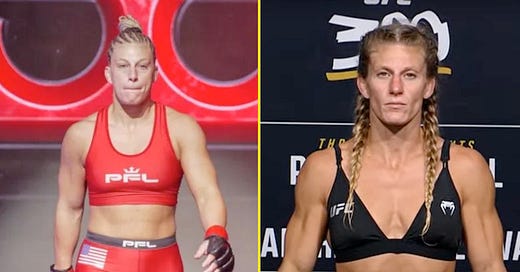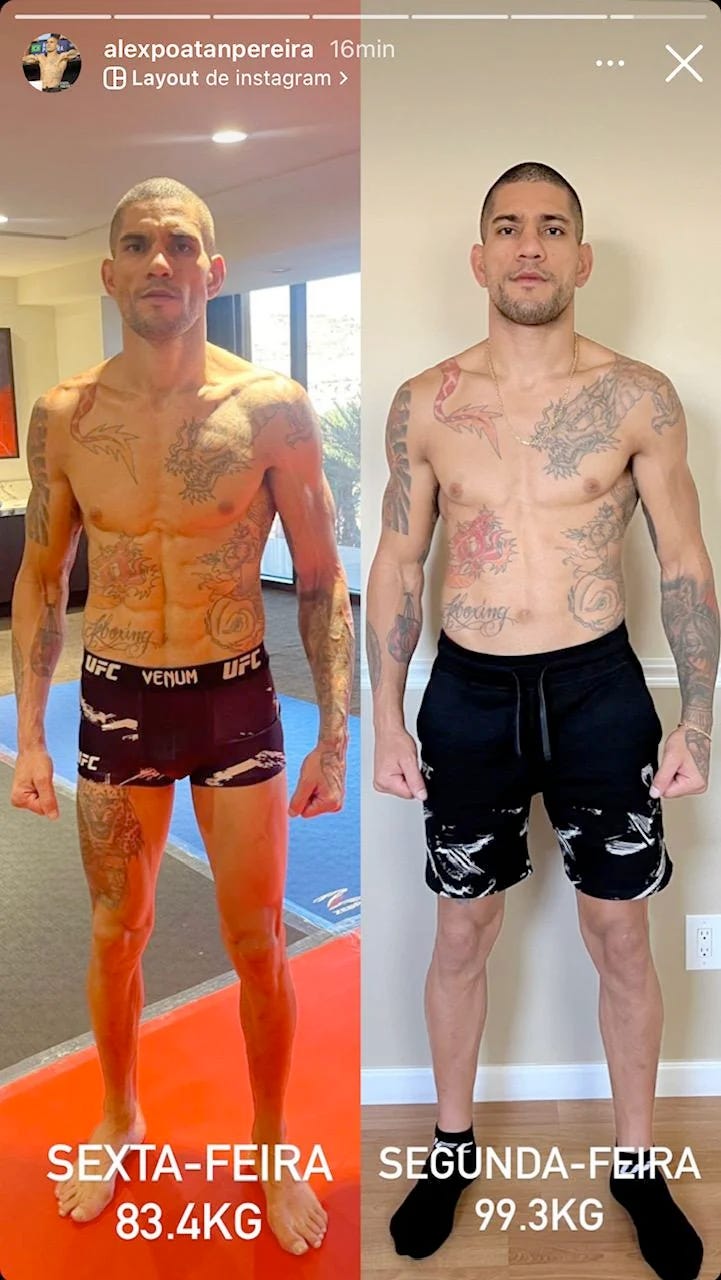The case for a women's openweight division
The war before the war - women having to make dangerous weight cuts just to be able to fight.
Hi friends,
Thank you all for the love on my Notes from UFC London. It truly was a dream come true to be able to sit cageside and be part of the media for the sport I love, and it has reignited my passion for MMA in spite of the far-right-ification.
For those who’ve been around for a while, you’ll likely have read/listened to an iteration of this piece. But, it feels like something I wanted to get down and out of my head in light of recent news.
Not a big long read this time around, but it’s probably the bastion of my MMA takes.
Thanks again,
Clara x
Kayla Harrison and the case for an openweight division
This week, it was announced that Kayla Harrison is due to fight for the bantamweight belt against Julianna Pena in June at UFC 316.
It is still surprising to me - and many - that the former lightweight is able to make bantamweight, challenging everyone's belief of what's possible when it comes to women’s weight manipulation.
After her gutsy decision win against Ketlen Viera last October, she spoke to TMZ Sports about how hard the weight cut is for her: peeing blood, muscle pain, how awful her body feels going below 150lbs. We’ve seen her post about being hungry on Instagram countless times, despite not being in an active fight camp.
And it's unsurprising she feels bad at bantamweight, given she was competing at 171lbs in the Olympics and 155lbs in PFL. She's 5’8, with biceps and lats bigger than most irrespective of gender.
Big weight cuts in MMA aren't new, with many choosing to make drastic cuts to gain a size advantage after rehydration on fight day. When Alex Pereira was fighting at middleweight, he was heading into the cage 20/30lbs heavier - heavier than some light heavyweights.
But, for taller or muscular women like Kayla Harrison, or Cris Cyborg or Megan Anderson, there's not been the choice there for them to fight close to their natural weights in the UFC.
They've been forced to put their bodies through hell, risking long term health issues - or worse - to fit into the limited weight classes.
This isn’t just speculation, either. In September 2024, 5’10 155lber Daiane Silva was hospitalised in a coma after cutting down to a late notice 145lb match up against Eman Almudhaf at Bellator London, with many worrying she would not pull through. It took weeks for her family to post, confirming she was on the mend.
It’s particularly dangerous for women to engage in such drastic weight manipulation due to the nuances of our bodies. Women’s essential body fat is approximately 10% higher than men’s due to the women’s hormonal needs - fat cells are major hormone regulators, especially when it comes to reproductive health.
According to most medical journals, it is generally agreed that a woman is likely to be in poor health if her body fat is below 14%, whereas men can push their body fat to 8% before they see negative side effects. As such, to make weight on a muscular or tall woman's frame means venturing into these scary low body fat percentages whilst simultaneously engaging in dangerous hydration practices.
Most divisions in Women's MMA stop at 155lbs, with most big promotions having either a 135lb or 145lb option. In the UFC, after they cut the featherweight division, there's only 3 weight classes remaining for women, with a 20lb difference between them. Men have 140lbs range to suit their different body types - flyweight to heavy.
For women who have bodies outside of this 20lb range, it's either make the weight or don’t fight at a high level. Their bodies may vary for reasons almost certainly outside of their control, too - taller, muscular, or various other genetic reasons that make weight manipulation harder.
And sure, the argument is always there that there's less women pursuing MMA than men.
Y’know, the sport where the main organisation only allowed women to compete in 2012, with Dana White stating a year prior that they would never be in the UFC.
There hasn’t been the visibility of women in the sport to create the talent pool yet, but year on year, more incredibly talented women make their way onto the amateur and regional professional scene who will need to find a home as they climb the ladder.
Furthermore, this is a problem other combat sports do not face. There’s heavy and openweight divisions in grappling, wrestling and boxing - or at least a far greater range for women to find a home in. Clarissa Shields, Kendall Reusing, Gabi Pessanha, Kennedy Blades - all incredibly talented, athletic women at the highest level of their combat sport.
With these heavy or open divisions existing in other sports, with high level women competing in them, it’s not a stretch to think that opening up a weight class opportunity for them in MMA would allow them to consider making the move across. I’d love to see how Reusing or Blades would do in the octagon with a few years of striking added to their already impressive arsenal.
My hope for women’s MMA is an expansion of weight classes across all promotions to allow women to compete without damaging their bodies.
One of my favourite proposals is creating an open/heavy division in the UFC - 145 to 170lbs - to allow for women like Kayla to truly perform to the best of their ability without risking their longevity.
Expanding the weight classes or opening up an openweight in MMA at the highest level could change the face of the sport.
And if the effect isn’t that profound, at the very least we can see women fight without risking their lives to do so.








